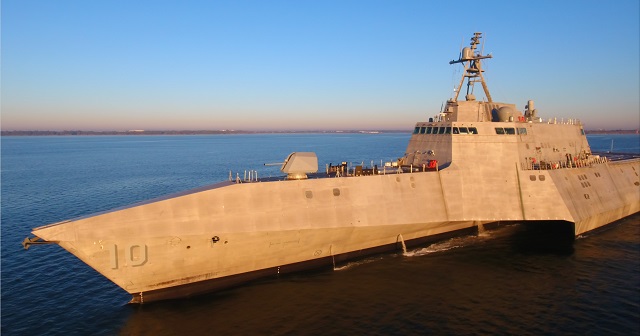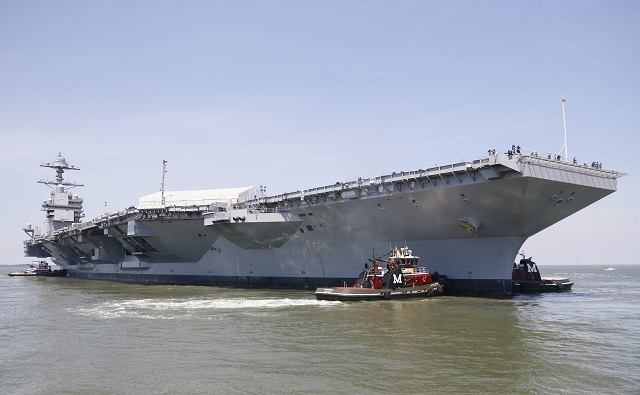U.S. Navy Will Add Nine Ships in 2017
.jpg)
The U.S. Navy is scheduled to add nine new ships in 2017.
The ships will include four littoral combat ships: USS Gabrielle Giffords, USS Little Rock, USS Omaha and USS Sioux City.
The navy also expects the USS Gerald R. Ford aircraft carrier.
The Navy Times reports the U.S. Navy is also expecting two destroyers, the USS John Finn and the USS Rafael Peralta, and two submarines, the USS Washington and the USS Colorado.
Leaving the fleet will be the submarine USS San Francisco which is planned to become a moored training ship. Two other submarines, the USS Dallas and the USS Buffalo are expected to leave active duty in 2017.
President-elect Donald Trump has said he plans to increase the fleet to 350 ships.
USS Gabrielle Giffords

USS Gabrielle Giffords is the ninth littoral combat ship (LCS) to be delivered to the Navy and the fifth of the Independence variant to join the fleet. The Independence variant is noted for its unique trimaran hull, ability to operate at high speeds and large flight deck size.
Following commissioning this year, the USS Gabrielle Giffords will be homeported in San Diego with her fellow ships USS Freedom (LCS 1), USS Independence (LCS 2), USS Fort Worth (LCS 3), USS Coronado (LCS 4), USS Jackson (LCS 6) and USS Montgomery (LCS 8).
The LCS class consists of two variants, the Freedom variant and the Independence variant, designed and built by two industry teams. The Freedom variant team is led by Lockheed Martin, with the Independence variant team led by Austal USA.
Each LCS will be outfitted with a mission package made up of mission modules containing warfighting systems and support equipment. A dedicated ship crew will combine with aviation assets to deploy manned and unmanned vehicles and sensors in support of mine countermeasures, anti-submarine warfare or surface warfare missions.
USS Gerald R. Ford
 The Gerald R. Ford-class is the future aircraft carrier replacement class for Enterprise and Nimitz-class aircraft carriers. The lead ship, USS Gerald R. Ford (CVN 78) is expected to be delivered this year. The class will be the premier forward asset for crisis response and early decisive striking power in a major combat operation. Gerald R. Ford-class aircraft carriers and carrier strike groups will provide the core capabilities of forward presence, deterrence, sea control, power projection, maritime security and humanitarian assistance.
The Gerald R. Ford-class is the future aircraft carrier replacement class for Enterprise and Nimitz-class aircraft carriers. The lead ship, USS Gerald R. Ford (CVN 78) is expected to be delivered this year. The class will be the premier forward asset for crisis response and early decisive striking power in a major combat operation. Gerald R. Ford-class aircraft carriers and carrier strike groups will provide the core capabilities of forward presence, deterrence, sea control, power projection, maritime security and humanitarian assistance.
The USS Gerald R. Ford is designed to operate effectively with almost 700 fewer crew members than a CVN 68-class ship. Improvements in the ship design will also allow the embarked air wing to operate with fewer personnel. New technologies and ship design features are expected to reduce watch standing and maintenance workload for the crew.
The USS Gerald R. Ford is the first aircraft carrier designed with all electric utilities, eliminating steam service lines from the ship, reducing maintenance requirements and improving corrosion control.
The carrier class is designed to maximize the striking power of the embarked carrier air wing. The ship's systems and configuration are optimized to maximize the sortie generation rate (SGR) of attached strike aircraft, resulting in a 33 percent increase in SGR over the Nimitz- class. The ship's configuration and electrical generating plant are designed to accommodate new systems, including direct energy weapons, during its 50-year service life.
The next two carriers of the Ford Class will be the USS John F. Kennedy (CVN 79) and the USS Enterprise (CVN 80).
USS John Finn

John Finn is the 63rd Arleigh Burke (DDG 51) class destroyer and the first of the DDG 51 Flight IIA restart ships.
DDG 113 is equipped with Aegis Baseline 9 combat system upgrades, which have increased computing power along with radar upgrades that improve detection and reaction capabilities against modern Anti-Air Warfare threats.
The shipyard is currently in production on future destroyers USS Ralph Johnson (DDG 114), USS Paul Ignatius (DDG 117), USS Delbert D. Black (DDG 119) and USS Frank E. Petersen, Jr. (DDG 121) and under contract for two additional ships awarded as part of the five-ship multi-year procurement for FY13-17. Another seven Arleigh Burke class destroyers are either under construction or contract at General Dynamics' Bath Iron Works shipyard.
USS Rafael Peralta

Following delivery, DDG 115 will be the 65th Arleigh Burke class destroyer and the first of the DDG 51 FLT IIA restart ships to be built at Bath Iron Works. The shipyard is currently in production on future destroyers USS Thomas Hudner (DDG 116), USS Daniel Inouye (DDG 118) and USS Carl M. Levin (DDG 120) and under contract for three additional ships awarded as part of the five-ship multi-year procurement for FY13-17.
USS Washington
USS Washington (SSN 787) is the 14th Virginia-Class fast attack submarine and the third US Navy ship named for the State of Washington. USS Washington is under construction at Huntington Ingalls Industries Newport News Shipbuilding. Virginia-class submarines are designed to conduct anti-submarine; anti-surface; strike; special operations; intelligence, surveillance, and reconnaissance; irregular warfare and mine warfare missions.
When delivered, the USS Washington will be the most technologically advanced submarine in service, as well as the least expensive. The Virginia-class is 7,800-tons and 377 feet in length, has a beam of 34 feet and can operate at more than 25 knots submerged. It is designed with a reactor plant that will not require refueling during the planned life of the boat.
